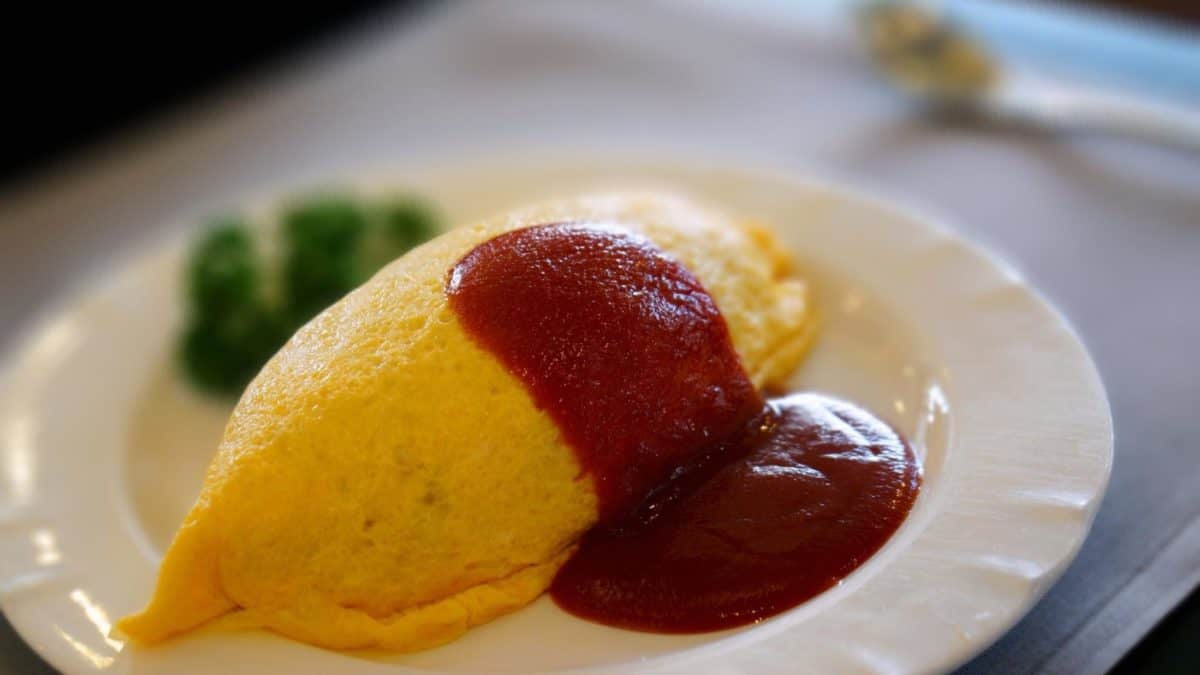Omurice: what is it & how did it originate?
Omurice (オムライス pronounced Omu-raisu) is an oval-shaped Japanese rice omelet wrap. It’s a tasty example of yōshoku (Western-style food), and the Japanese consider it the “ultimate breakfast omelet” because it contains many tasty ingredients.
The rice is pan-fried with some ketchup and chicken. Then it’s wrapped in an omelet.
Think of it as an omelet burrito with rice, chicken, and ketchup filling. It’s the perfect fusion breakfast that’s going to keep you fuller than a bowl of oatmeal.

Omurice is best known for its sweet and savory flavor and is popular in Western-style Asian cafes.
The best omurice is served in a burrito style, with the omelet exterior and the meaty fried rice and ketchup interior.
Some people also like to place the rice into a mound and drape the omelet over the mound and douse in ketchup.
Whichever way you prefer, the end result is very tasty. You can actually find omurice in many Asian countries but it’s most popular in Japan, South Korea, and Taiwan.

Check out our new cookbook
Bitemybun's family recipes with complete meal planner and recipe guide.
Try it out for free with Kindle Unlimited:
Read for freeIn this post we'll cover:
Origin of omurice
There’s not much information about the origin of omurice, but as with many fusion foods, it’s believed that omurice was invented at the turn of the 20th century.
Since Western foods became increasingly popular, it’s no wonder that the banal omelet was reinterpreted in a Japanese way.
The recipe was popularized by a restaurant called Renga-tei in Tokyo’s Ginza district.
Apparently, the dish was first marketed as the perfect children’s breakfast, but I’m not surprised that adults loved it too!
It then migrated to Taiwan, Korea and became a regular on gimbap restaurant menus across Korea.
The next time you’re craving egg, consider this tasty omurice recipe. It’s a step up from a regular omelet, and it really doesn’t take long to make.
What’s the difference between omurice and french omelet?
Omurice is a dish made of rice and chicken, wrapped in an omelette. It’s popular in Japan, and sometimes called “rice omelette” or “omelette rice”.
French omelet, on the other hand, is a dish made of eggs, milk, butter, and flour. It’s popular in France.
What does “omurice” mean?
Omurice is a combination of the Japanese words for “omelette” (omuretsu) and “rice” (raise). It’s pronounced oh-moo-ree-tse.
Popular omurice seasoning
Ingredients include ketchup, Worcestershire sauce, soy sauce, and salt.
Omurice is often served with a side of vegetables or salad, and it can be garnished with parsley or other herbs. The dish is usually made with chicken, but it can also be made with beef, pork, shrimp, or other ingredients.
Popular omurice pairings
Omurice goes well with a variety of different dishes. Popular pairings include curry, soup, and bread.
Health benefits of omurice
Omurice is a good source of protein and vitamins. It’s also low in fat and calories, making it a healthy option for people who are trying to lose weight or maintain a healthy weight.
Conclusion
Omurice is a delicious and versatile dish that can be enjoyed in many different ways. It’s perfect for a quick meal or a more leisurely dining experience. Whether you enjoy it with chicken, beef, pork, or shrimp, omurice is sure to please.
Check out our new cookbook
Bitemybun's family recipes with complete meal planner and recipe guide.
Try it out for free with Kindle Unlimited:
Read for freeJoost Nusselder, the founder of Bite My Bun is a content marketer, dad and loves trying out new food with Japanese food at the heart of his passion, and together with his team he's been creating in-depth blog articles since 2016 to help loyal readers with recipes and cooking tips.
